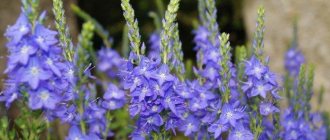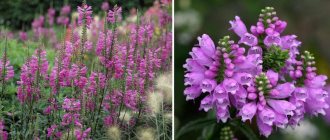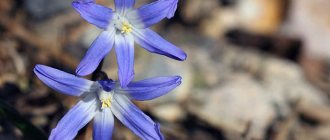Astilbe planting and care in open ground which will be described in this article, is especially valued by gardeners for its unusual appearance, long flowering period, ability to easily tolerate waterlogging and shade tolerance. This plant looks beautiful not only when it blooms. From spring to late autumn, astilbe decorates the flowerbed with openwork leaves on reddish petioles.
Our article provides a detailed description and photo of the plant. You can learn more about planting methods and features of growing astilbe by watching the video at the end of the article.
The plant is suitable for forcing and cutting. Astilbe bushes are covered with lush foliage, which will be a wonderful decoration for flower baskets and bouquets.
What does astilbe look like when it blooms?
The herbaceous plant astilbe is a member of the saxifrage family. The first representatives of this culture grew in Japan, East Asia and North America. There are about 40 species of this plant and more than 400 varieties.
- The height of the bush can vary from 1 to 2 m.
- Flowers are collected in paniculate inflorescences 10-60 cm long. Flower colors can be very diverse: white, red, pink and purple.
- The color of the foliage can be dark green, burgundy, bronze.
- In the form of a fruit - a capsule with small seeds.
- The flowering period is from June to August.
What plants to combine astilbe with
This plant has, as we have already said, a great variety of beautiful shades. Therefore, astilbes look great in group plantings in the form of multi-colored bushes. They grow up to about 50 cm, depending on the variety you choose.
Astilbes of the same color, planted in a flower bed, look very interesting. They look like a big fluffy cloud lying on the grass.
However, I like it best when astilbe is combined with other shade-loving plants. And the first neighbor of astilbe, which suits it perfectly in all respects, is the hosta.
Astilbes look great in alpine slides next to stones. At the same time, these plants look equally beautiful both on the ground, surrounded by other flowers, and in plantings between stones, when the ground around is covered with gravel. In such plantings, astilbe looks very beautiful with conifers.
Astilbes are very good among large stones. Given their love for moisture, you can make a small decorative pond near them.
Astilbe varieties
More than 400 varieties of astilbe, differing from each other in size, flower color and leaf shape, have been bred by scientists. The most famous and popular types include:
David. The bush can reach a height of 150 cm. The inflorescences are arranged horizontally, looking down, the flowers are lilac-pink. Flowering period from July to August.
Naked. Plant height up to 20 cm. Flowering in June and July. The foliage has a bronze tint.
Chinese. The bush can reach a height of up to 100 cm. The flowers of the plant are pink, lilac or white, and the leaves are covered with reddish fluff. The inflorescences are up to 30 cm long. The flowering period lasts from June to August.
Japanese. Reaches a height of about 70 cm. The bush grows well, forming a circle of wide diameter. Inflorescences up to 30 cm long, diamond-shaped, flowers pink, red, white.
Flowering period is mid-summer. This variety is distinguished by its resistance to cold, and also by the fact that it takes root well.
Thunberg. The height of the bush is up to 80 cm, the flowers are white, the edges of the leaves are jagged. The inflorescences are sparse, looking down, the width of the panicle is 10 cm, length – 25 cm. Flowering period: July-August. This variety belongs to the pyramidal species, characterized by spreading shoots, which are covered with dense foliage. The species reacts poorly to low air humidity and heat.
Astilbe in landscape design
Landscape designers value astilbe for its long-lasting decorative effect, resistance to high groundwater levels, and ability to grow in the shade of tall plants
Openwork leaves sitting on reddish cuttings attract attention throughout the garden season.
Young purple leaves that gradually turn green and take on an unusual shape look attractive in the flower garden. An additional bonus for carved leaves is a long flowering period, more than a month. Various shapes and shades of inflorescences decorate the flower garden from mid-summer to autumn.
Astilbe can be used in creating flower arrangements both individually and in group plantings, combining the colors and sizes of different varieties.
Planting in groups
Astilbe is a universal plant; it will be welcome in any type of landscape design. Low-growing bushes can be used in the foreground of the composition, while medium-growing bushes will decorate the middle and background of the plantings. Tall ones will decorate what you want to hide, camouflage outbuildings or an unsightly fence. Low-growing varieties will be appropriate on an alpine hill or scree. They can also be used to frame garden paths.
Planting in flower beds
Low-growing varieties of astilbe can be used as a border for flower beds and lawns. An astilbe bush in a flower pot will decorate an open veranda or garden gazebo. This perennial looks impressive against the background of conifers such as thujas or junipers. A successful combination of astilbes with hostas and ferns.
The carved leaves of the perennial will look even more delicate when planted together with hellebore, bergenia, podophyllum, Rogersia or mantle. A very interesting combination of astilbe with daylilies, aquilegias, lilies, geraniums, phlox or ferns. Planted together with hosta, astilbe enhances the beauty of its leaves, and the leaves retain soil moisture for astilbe.
The joint planting of astilbe and ground cover plants (saxifrage, tenacious, jasmine) achieves two goals - in early spring, when the astilbe is not yet visible, the ground covers create an attractive spot, then the astilbe that has grown and gained color attracts attention to itself. In the hot season, ground covers protect the astilbe growth site from overheating
In the spring garden, astilbe plantings are combined with primroses, crocuses, lilies of the valley, rhododendrons, and tulips.
Planted in the company of tall flowers, astilbe camouflages the bare stems of its neighbors. It is one of the rare ornamental plants that grow and bloom well in conditions of lack of sun and excess moisture. If necessary, you can plant astilbes under trees, but this must be done at least 1.5 meters away from the tree trunk. With such planting, the roots of the tree will not be damaged and the astilbe will not be oppressed.
Preparing for landing
It is advisable to choose a site for planting astilbe with close contact with groundwater. The plant can also be planted on the shore of a pond located in the garden. Since sandy soil does not retain moisture well, the area above must be mulched with peat.
Recommendation! Before planting, the soil on the site should be dug up, roots removed and organic matter added.
If astilbe was purchased in a store, then before planting you should soak the rhizome in warm water for 1 hour. It is recommended to add potassium permanganate to the water to make the solution pale pink.
Watch the video! How to plant astilbe
Flowering conditions
Astilbe blooms from the last days of June until the beginning of September. It all depends on the specific variety.
In order for flowering to be lush and long-lasting, astilbe should be planted in areas with sparse shade, away from direct sunlight. For example, along the banks of artificial reservoirs or near the northern wall of your site. Although there are varieties that feel great in the sun.
Astilbe loves moisture, so it can be planted in areas with high groundwater levels. The main thing is not to let water stagnate at the roots. But drought is much more dangerous for astilbe. If the summer turns out to be especially hot, then watering the astilbe needs to be more frequent. Also don't forget about mulching. This will help retain moisture in the soil longer. In addition, the plant cannot tolerate overheating of the roots, which are very close to the surface.
Astilbe flowering
How to care after flowering?
After the astilbe has bloomed, nothing needs to be done until the very end of the summer season. Firstly , even dry inflorescences on a bush look beautiful. Secondly , this is how the seeds finally ripen.
Around mid-October, with the onset of cold weather, astilbe is pruned. Dry branches can be burned, or you can take them home and decorate your room with them.
At the same time, the last fertilizing of the astilbe of the year is carried out. Compositions with phosphorus and potassium are chosen as fertilizers. Nitrogen fertilizers cannot be used in the fall.
Next, loosen the soil and mulch. This plant is frost-resistant, but it may suffer after thaws and subsequent cold snaps. Therefore, with the first frosts, astilbe is covered for the winter with dry grass or covering material.
Planting astilbe
Planting technology:
- The first step is to dig a hole 30 cm deep.
- Organic fertilizer (compost) should be poured into the bottom of the pit, which is used in the proportion of 2 buckets per 1 sq.m.
- It is recommended to add 1 tbsp to the hole. complex fertilizer of any type containing nitrogen, phosphorus, potassium (nitroammofoska) or 2 handfuls of ash.
- Then the fertilizer is mixed with the soil.
- Then pour water into the hole.
- Astilbe should be planted in the ground, deepening the root collar by 5-6 cm. After the water in the hole is absorbed, 3-4 cm of dry soil should be poured on top, which will help retain moisture in the rhizome area for as long as possible.
- The mulching procedure will help retain moisture in the hole for a long time, and also facilitate the adaptation of the plant. Sawdust, humus, pine needles, and crushed bark can be used as mulch.
Astilbe grows very slowly, so it is recommended to plant it densely: 20*20 cm. The planting will become dense next year. It will be possible to thin out the plants in 2-3 years.
The astilbe flower goes well with other types of plants. The easiest way to grow is in mono-plantings using one variety. You can also plant the plant in groups, using several varieties with flowers of the same tone, but of different heights.
How to plant astilbe seeds for seedlings in spring
One way to grow astilbe is from seeds. The method is not complicated, but rarely used. The fact is that flowering, with this method of planting, begins in the 3rd year and, most importantly, many parental characteristics are not transmitted through seeds when planted; in the end, you may end up with something completely different from what is shown on the package of seeds.
Sometimes plants appear with very similar characteristics to the mother, and sometimes similar to another variety. By the way, sometimes completely inconspicuous specimens grow. In any case, if you are interested, experiment.
When to plant perennial astilbe
The best time for planting seeds is February-March. In this case, the planted seeds will have time to grow and get stronger by June, and those transplanted into open ground will take root and get stronger for wintering. If you purchased an already sprouted sprout, then the best time for planting is the end of May, when the return frosts have passed.
How to grow astilbe from seeds at home for seedlings
If you nevertheless decide on this method of planting, then first prepare the soil. As I already wrote, astilbe does not make any special demands on the soil, so for planting you can take a regular soil mixture, adding a little peat and sand to it for looseness. Pour it into the box and smooth it out.
Before sowing, water the soil well, let the water soak in, and then spread the seeds over the surface without sprinkling anything. It is more convenient to do this with a slightly moistened toothpick, since they are very small. Then cover the box with the plantings with glass or a bag. Now all your attention should be paid to ensuring that the earth does not dry out even for an hour. Water carefully, along the edges of the box, the soil will soak itself.
Maintain the temperature for germination at 18-22 degrees. The germination rate of the seeds is very low; seedlings will appear in 3-4 weeks. If after 3 - 4 weeks the seedlings have not appeared, it is recommended to carry out stratification, i.e. put the box with seeds on the bottom shelf of the refrigerator at 2-4*C for another 2-4 weeks.
The hatched seeds are transplanted into pots and left in a bright place at a temperature of 18-20*C. Grown plants are planted in open ground in May-June, when the risk of return frosts has passed.
Care and cultivation
The main methods of caring for flowers include:
- weeding;
- loosening;
- watering;
- mulching.
Watering
Astilbe needs constant watering. It is recommended to ensure that the top layer of soil is constantly moist, since the root system can only develop well in moist soil. It is necessary to water the flower at least once a week; in hot weather, this procedure must be carried out at least 2 times a week. Astilbe can be watered either at the root or using the sprinkling method, since this plant is resistant to the appearance and spread of fungal diseases.
Even a short drying of the soil in the area can cause the astilbe leaves to wither, the inflorescences to become smaller, and the bush itself to look sloppy. In order to prevent these undesirable consequences, you should mulch the plant with any organic material:
- dry leaves;
- sawdust;
- bark
Advice! It is best to use compost for mulching, since it is an organic concentrated fertilizer and maintains a sufficient level of moisture in the area.
Fertilizer
The bulk of fertilizers should be applied to the site when planting astilbe. The plant really loves organic fertilizers. It is recommended to add up to 1 liter of humus to the planting hole, after which the composition should be mixed well with the soil.
- In the spring months, the plant must be fed with nitrogen fertilizers. It will be enough to hill up the astilbe with humus or add a urea solution to the area in a proportion of 1 tsp. granules for 5 l. water.
- Before flowering begins, in the summer, it is recommended to apply potassium fertilizers. For example, you can prepare a composition from potassium nitrate (2 tablespoons) diluted in 10 liters of water. Each bush should be watered at the rate of 0.5 liters per 1 bush.
- Phosphate fertilizers should be used in autumn. At the rate of 20 g of superphosphate per 1 bush.
After flowering is completed, in the autumn, several buds form at the base of the shoot formed this year. These will subsequently develop rosettes of leaves. Next year, flower stalks will appear from the rosettes. Small buds located below will begin to develop only next year.
Advice! The plant annually rises above the site by a distance of 3-5 cm. Therefore, every year it is necessary to add fertile soil to the site.
Basics of caring for astilbe
Growing perennials in open ground does not cause gardeners any problems or worries. The main thing is that the right place for the plant is chosen.
We remind you that the ideal site is characterized by:
- diffused shadow created by bushes or trees;
- moist air provided by a pond or stream.
Adequate water as a vital requirement
Changes in moisture conditions are immediately reflected in the appearance of astilbe. Growing in sunny areas, coupled with a lack of moisture in the soil, leads to a smaller size of bushes and panicles.
Additionally, the following consequences are observed:
- delay in the growth of rhizomes;
- leaf fall;
- reduction of flowering time;
- loss of overall decorative effect.
With low air humidity and constant windiness, the plant can curl up and shed its leaves, astilbe burns and dries.
In this case it is necessary:
- re-mulch the soil;
- water the plant abundantly and regularly;
- spray greens;
- organize artificial shading during hot hours;
- take care of denser planting of perennials.
On a note! Astilbe has the ability to crowd out weeds. The flower garden will always look well-groomed.
Drought-resistant varieties
Today, breeders have managed to develop perennial specimens that are tolerant of arid climates. Thus, Japanese astilbe is able to survive even in conditions of lack of water. The scorched greenery will die, but in the spring the plant will again throw out young shoots. Don’t rush to uproot a flower that was ruined this year. At least give the rhizome a chance to show its strength next season.
Relatively dry soil will not harm Astilbe Chinese Superba and Purpurlance.
Flowering period
The flowering time of astilbe depends on the variety and climatic conditions. In general, panicles mature within 60-120 days after awakening (exiting the dormant period).
Usually, Japanese astilbe and all low-growing varieties are the first to open, followed approximately simultaneously by simple-leaved, Thunberga, as well as medium-growing hybrids of Arends and Lemoine. Chinese perennials are closing their flowering season.
The duration of the riot of colors directly depends on the climatic characteristics of the area and varies between 12-35 days. At the end of flowering, individual astilbes do not lose their natural color, creating the effect of an incredibly long flowering period.
On a note! Gardeners note that panicles fade faster in sunny areas than in shady areas.
If there is no goal to stock up on seeds, semi-dry astilbe brushes are cut off. At the same time, the bushes do not lose their decorative properties. Red, brown, brown-green and green foliage retains its beauty until frost. The main thing is that the autumn should be warm, the air should be regularly saturated with moisture, and the temperature should drop slowly (gradually).
“Successful Tips” will teach you how to properly prune faded astilbe:
Loosening
Mulching helps retain moisture in the soil, but is not able to saturate the soil with oxygen. Spring and summer rains greatly compact the soil, preventing plants from “breathing.”
Loosening allows you to increase the air permeability of the soil around the astilbe and control weeds. It is useful to hold the event 2-3 times per season.
During loosening, the soil is not turned over. The main task is to destroy the crust on the surface of the hole. The procedure is carried out carefully with an ordinary weeder, focusing on a depth of 5-10 cm.
Feeding
How to grow a healthy and strong plant? You just need to root a high-quality seedling in the ground, create a shaded environment and ensure a regular supply of moisture to the roots. Astilbe will grow, bloom and delight the gardener's eye.
It is impossible to say that a perennial vitally needs regular feeding. However, pampering your favorite bush with “goodies” is also not prohibited.
Gardeners feed astilbe 3 times a year: in the spring - with nitrogen fertilizers, in June (when it blooms) - with complex complexes, until August 10-15 - with phosphorus-potassium compounds and ash. In the latter case, the plant’s resistance to pests and diseases, as well as its winter hardiness, increases.
Reason for dividing the rhizome and time of transplantation
In a favorable atmosphere, astilbe will soon grow. The root collar rises above the ground by 3-5 cm over the course of a year. At first, it must be hilled up (sprinkled with soil), otherwise the perennial will stop blooming. After 4-5 years, the plant must be replanted.
The peculiarity of the astilbe rhizome is such that the growth of renewal buds occurs not horizontally, but vertically, and near the very surface of the earth. If young roots are left without soil cover, they will die: they will dry out in the summer or freeze in the winter.
On a note! Grinding of flower stalks and perennial bushes is a direct signal about the exposure of the root collar and shoots.
In one place, astilbe can grow for up to 20 years. However, in this case it is better not to wait for lush vegetative mass and large panicles. If the gardener wants to increase the decorativeness of the bush, he should regularly (with a frequency of 3-4 years) divide the rhizome into parts and replant the sections to a new place of residence. This is the most common method of propagating astilbe and a separate story that deserves attention. The benefit of the event is obvious - there are more flowering bushes and the garden is more beautiful.
It is believed that the best period for transplantation is spring (without frost) or autumn (late August - September). Astilbe divisions must have time to take root before wintering. To reduce the stress of a transplanted plant, the greens can be sprayed with epin or phytosporin. Adaptation will happen faster and with the least losses.
On a note! Gardening practice has shown that, contrary to literary instructions, astilbes take root well at any time of active growing season, even during the flowering period!
How to care for a transplanted division? In the usual way:
- maintain soil moisture by mulching;
- feed after establishment three times a year;
- trim the discarded flower stalks once after replanting to allow the plant to grow stronger.
Reproduction
Astilbe can be propagated:
- division of roots;
- cuttings;
- kidney renewal;
- seeds.
Dividing the bush
Even old bushes can be used for propagation, since after the procedure dormant buds awaken on them.
The division procedure should be carried out more often than once every 3 years. The plant should be dug up in early spring - in March, or at the end of August.
When propagating a bush by division, you need to ensure that each division has 3-4 buds. The rhizomes are divided into 4-5 parts and planted in a new area, maintaining a gap of 35-40 cm between the bushes. The cut areas on the roots are treated with crushed charcoal.
Kidney renewal
- At the beginning of spring, when the young shoots have not yet had time to grow, it is necessary to cut off the buds with the beginning of the rhizome using a sharp garden knife, and then treat the cuts with wood ash.
- The planting material obtained in this way is planted in a mixture consisting of 3 parts peat and 1 part gravel, and then covered with film to create a greenhouse effect.
- Then you should wait for the shoot to take root, which occurs within 3 weeks.
- Young and strong bushes are transplanted to a permanent place in early autumn, or next spring.
By cuttings
- After the bushes reach a height of 10-15 cm, they can be cut and divided into cuttings.
- Then the shoots should be planted in a box filled with a mixture of peat and sand in a 1:1 ratio and watered.
- After which you need to spray the plant with a spray bottle 2 times a day.
- During rooting, the air temperature should be maintained within 20-22 degrees.
- The peduncle formed on the cutting should be removed.
Seeds
The method of propagation by seeds is most often used for selective work, since they do not germinate well.
- Seeds should be sown in the garden bed in spring or autumn, without covering them with soil. The location for the plant is best chosen in the shade.
- The first shoots appear after 10-15 days, and if sowing was carried out in the fall, then in the spring.
- After the plant has its first true leaf, the seedlings should be planted at a distance of 15 cm from each other.
- Stronger bushes can be planted in a permanent place.
- Young plantings are covered with leaves for the winter.
When propagating from seedlings, pre-stratified seeds should be sown in early or mid-March.
- The seed is placed in a planting container 15-17 cm deep with a sand-peat mixture and covered with a layer of snow.
- Melting snow will gradually moisten the soil and allow the seeds to sink to the depth necessary for cultivation.
- The crops should be placed in a cool place for 3 weeks, first covered with film.
- After the first true leaves appear on the sprouts, the picking procedure should be carried out.
- Caring for the plant in the future consists of watering and maintaining a temperature regime of 20-22 degrees.
Watch the video! Astilbe planting and care. Astilbe sowing seeds
How does a flower reproduce?
Garden azalea - planting and care in open ground
Astilbe propagation is carried out through seeds, cuttings and dividing bushes.
Rosette division is the most popular method of propagating astilbe.
Cuttings
During the spring growing season, buds that have produced new shoots are cut off with a sharp blade. Ash is applied to the cut areas. New shoots are planted in moist soil with a high content of crushed gravel or coarse sand, where a greenhouse effect is created. Greenhouse conditions are also suitable.
Note! This method helps to increase the adaptive capacity of the cuttings, but they will need about a year to turn into a full-fledged flower.
Germination of seeds
Opinions differ about the benefits of seed growing. Its supporters argue that this is the only way to obtain new varieties. Opponents claim that to preserve varietal qualities, only high-quality selection seeds are suitable, otherwise the crop may turn out to be distorted.
As arguments, they cite the risks of such deviations:
- color changes;
- intermittent inflorescences and non-standard shapes of panicles;
- reduced decorativeness;
- change in flowering period.
The seed is placed on moist soil, where it is provided with greenhouse conditions. High humidity accelerates growth; the main threat to young plants is lack of water. They need good lighting, but plantings must be protected from direct rays.
Additional Information. Stratified seeds develop faster; seedlings can be placed in the garden within a couple of months. The seeds are kept at a temperature of -4°C to 4°C for about three weeks, then they are sown in a greenhouse with a temperature of 20°C. By the time they reach open ground, these seedlings adapt better.
Dividing an astilbe bush
This method of propagating a bush is popular for its high degree of reliability. The main plant is carefully dug up in early spring, its tender rhizome is cut into sections with 3-2 buds. The sections are treated with ash, then normal planting is performed.
It is recommended to supplement the applied fertilizers with root growth stimulants. Plantings are regularly loosened and watered; new astilbes can bloom as early as September.
Diseases and pests
The plant very rarely becomes a victim of diseases and pests; in rare cases it can be affected by:
- slobbering pennies;
- root-knot nematode;
- strawberry nematode.
Pennywort is usually located in the leaf axils of the plant. After some time, saliva-like secretions appear inside them in the form of foam, inside of which the leafhopper larvae are located. Affected leaves wrinkle and become covered with yellow spots. In this case, the bush completely or partially fades.
In order to get rid of this pest, you should use:
- Rogor;
- Confidor;
- Aktaru (2-3 g per 10 liters of water);
- Karbofos.
The buds, flowers, and leaves of the plant are susceptible to the spread of the strawberry nematode. The affected areas of the bush are deformed and covered with necrotic spots of brown or yellow color. Astilbe growth deteriorates.
The root-knot nematode most often affects the roots of the plant and appears in the form of small galls (growths) on their surface, inside which the nematodes are located. The galls are clearly distinguishable already in the second period of the growing season. The flowering and growth of affected bushes noticeably deteriorates, and in some cases the plant dies. Therefore, shoots that show obvious signs of disease must be dug up and destroyed.
Important! During the first growing season, it is very important to carry out the first weeding on time. During the second growing season, the overgrown root system of the plant will independently choke out the weeds.
It is recommended to treat astilbe with Fitoverm.
The young foliage of the plant sometimes suffers from frosts that occur in late spring, but this cannot become an obstacle to the appearance of new leaves and flowers. Perennial astilbe tolerates harsh winters well, but suffers from spring frosts and wetness. The plant is suitable for cultivation in regions with unfavorable climatic conditions, including the Urals , Siberia .
Important! The varieties that have the greatest decorative value, with large inflorescences, can freeze slightly.
Top dressing
Astilbe is fed three times a year: in spring, summer and autumn.
Spring feeding is aimed at stimulating plant growth, the appearance of foliage, shoot development and budding. At this time, nitrogen fertilizers are used.
In summer, fertilizing is applied before flowering begins. The fact is that the formation of flowers is a very energy-consuming process for a plant. And he needs additional feeding. Potash fertilizers are used. For example, you can add a solution of 2 tbsp. potassium nitrate and a bucket of water.
The purpose of autumn feeding is to prepare the plant for wintering. At this time, phosphorus fertilizers (for example, superphosphate) are applied.
IMPORTANT! It is best to apply fertilizing after watering. Then the soil needs to be loosened and mulched.
Preparing for winter
On bushes that have already bloomed, the panicles must be removed so that they do not set seeds. This procedure will preserve the plant’s strength for wintering.
In winters with little snow, astilbe must be additionally covered:
- In autumn the bush should be pruned.
- Then install a light frame over it.
- Fill the inside of the frame with leaves.
- Lutrasil or spunbond is tightened on top.
- Then cover with plastic to protect from moisture. The edges are pressed with bricks.
Description
Astilbe is classified as a herbaceous perennial belonging to the Saxifraga family. The plant's homeland is East Asia, North America, and the Japanese Islands.
In nature, the flower prefers deciduous forests and damp places (near the banks of streams). In Russia, the flower is mostly known to the central regions; it is cultivated in Siberia and the Urals. The plant is not afraid of snowy winters and low temperatures.
The perennial is distinguished by basal long-petioled matte, non-shiny openwork leaves. The color of the simple or pinnately dissected foliage is dark green, bright green, with a reddish or burgundy tint.
Astilbe bushes have erect stems, the height of which is determined by the plant’s belonging to a particular species. Bushes of the “Liliput” variety grow up to 15 cm, hybrid Arends species tend to reach 2 m (David’s astilbe).
In a woody, dense or loose rhizome, depending on the type, daughter buds appear on the upper part every year, amounting to an increase of up to 5 cm. The old part dies off.
Astilbe is especially beautiful during flowering. Its flowers are miniature in size - up to 8 mm. They are collected at the top of the bush in panicle inflorescences, varying in length.
There are pyramidal, rhombic, paniculate, drooping forms of inflorescences that give astilbe a unique charm. One plant can grow from five to fifty panicles.
The wide color palette of the plant's flowers includes white, pink, creamy white, lilac, red, purple and other shades. Types of perennials with short flower petals are airy and delicate; elongated petals give the plant softness and fluffiness.
The plant blooms in June and delights with lush, delicate inflorescences until August. Faded plants form fruits in the form of boxes, which contain a large number of seeds (up to 20,000 in one gram).
Today there are up to 40 species of astilbe and up to 400 of its hybrid varieties. The perennial was discovered by the Scottish lord Hamilton, traveling across the expanses of China.
Because of the dullness of the leaves, the botanist gave the plant an unpretentious name, meaning literally “without shine” (“a” - “without”, “stilbe” - shine). Thanks to lovers of unusual flora representatives Carl Thunberg and von Siebold, astilbe appeared in Europe at the beginning of the 19th century.
One of the first to breed astilbe was E. Lemoine, a Frenchman. The fruits of his labors are the birth of “Rubella”, “Mont Blanc”, Plumet Neuhaus”, “Coat of arms of Neiges” - the most beautiful plant species.
Astilbe became famous with the works of Georg Arends. The German breeder was engaged in improving the color scheme of plants, flowering times, and the shape of inflorescences. Arends bred 84 varieties of astilbe. His results did not leave indifferent the Dutch botanist V. Reis, who created 20 species of astilbe, and other professional connoisseurs of the ornamental plant.
Astilbe is an excellent specimen for decorating a garden plot. Traditionally, it gets along with hostas, ferns, and Siberian iris. The plant forms wonderful compositional combinations with paniculate phlox, bergenia, heuchera, tiarella, and garden bells.
Astilbe - description, appearance and features
What is astilbe? This is a perennial plant from the Saxifragaceae family, with lacy foliage and beautiful fluffy panicle inflorescences.
When does astilbe bloom? It blooms starting from the first days of summer. How long does astilbe bloom? The plant blooms most actively for about a month. The flowering process itself continues until August. Not only the flowers are decorative, but also the long-petioled dark green leaves growing on erect stems. The color range of lush panicles is rich in a variety of shades: white, cream, pink, lilac, red. The delicate aroma of astilbe is somewhat reminiscent of the fragrance of bird cherry.
The birthplace of the flower is Japan and Asia. The number of varieties reaches 200 varieties. There are dwarf varieties, for example, Lilliput. There are tall varieties, for example, Arens hybrids. Compliance with simple agrotechnical rules allows even a novice gardener to grow a lush, eye-catching plant - which is why this crop is so loved by many. For ideal growth and development, astilbe needs shade, but not too strong. The so-called “lace” shadow from the tree crowns is what you need.
With the onset of cold weather, the above-ground part dies off, and the overwintered root produces new shoots in the spring. A remarkable feature of astilbe is that its rhizomes grow from above. Thus, buds form on the upper part of the root system, which are exposed, and therefore require annual addition of soil. Every year their size increases, forming new roots, while the lower part gradually dies off. Panicle flowers reach from 10 to 50 cm in length; when the flowering period ends, boxes with seeds inside remain in their place.
The height of an astilbe plant depends on the variety. There are tall varieties, and there are dwarf ones. For comfortable cultivation, it is preferable to choose tall varieties - those that grow up to 50-80 cm. They are more resilient and tolerate climate changes and temperature changes well.
As mentioned above, there are many different types of this plant, but most summer residents liked Japanese astilbe. This variety is also called Montgomery - a hybrid bred by German breeder Georg Arends in 1837.
Astilbe Montgomery
Arends hybrids are the brightest, most beautiful, unpretentious, they grow well on any soil, are resistant to cold, and bloom for a long time (about 40 days). In addition to "Montgomery", "Gloria", "Deutschland", "Europe", and "Rheinland" are popular among gardeners.
Japanese astilbe grows up to 80 cm in height, has ornamental leaves, and its flowers bloom early. After the flowers fade, they do not lose their decorative qualities, do not spoil the overall picture of the garden, and are often used to make dry bouquets.











